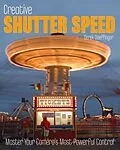A unique guide to creative shutter speed techniques, illustratedwith striking full-color examples Along with available light and aperture, shutter speed is one ofthe variables that determine exposure-the amount of lightthat reaches the camera's sensor. Set on automatic modes, camerastypically attempt to reduce or eliminate blur in a picture. But bymanipulating shutter speed creatively, photographers can achieve arange of striking motion blur or stop-action effects. Using anarray of inspiring photographs depicting people, wildlife, andlandscapes, Creative Power of Shutter Speed explains how to "read"the light and movement in a potential photograph and identify thebest shutter speed for the desired effect.
Autorentext
Derek Doeffinger, a former writer/photographer for Kodak, has been writing about digital photography since the first dSLR was introduced over 15 years ago. He is the author or co-author of ten how-to photography books and three scenic photo books: Waterfalls and Gorges of the Finger Lakes, Finger Lakes Splendor, and Waterfalls of the Adirondacks and Catskills.
Klappentext
Learn to unleash the power of every shutter speed
Shutter speed is an integral part of exposure. Learn to use it creatively, and you unlock the magic that transforms an ordinary subject into a work of art. From the blazing 1/8000 second that captures each feather in a hummingbird's wing to the lazy half-second that turns a fireworks display into a color-rich patchwork, shutter speed allows you to freeze time. Derek Doeffinger teaches you to harness the power that separates the amateur from the professional.
- Unleash the power of shutter speed from 1/8000 second to 8 hours
-
Learn creative techniques to transform your photos
-
Discover how to achieve different effects with various aperture/shutter speed combinations
-
Determine the effect of weather and lighting conditions
-
Use filters, lenses, tripods, and other tools to manipulate shutter speed
-
Explore stop-action and creative blur techniques
-
See how to reinforce your creative vision using Photoshop
-
View what you can achieve in stunning full-color examples
Zusammenfassung
A unique guide to creative shutter speed techniques, illustrated with striking full-color examples
Along with available light and aperture, shutter speed is one of the variables that determine exposurethe amount of light that reaches the camera's sensor. Set on automatic modes, cameras typically attempt to reduce or eliminate blur in a picture. But by manipulating shutter speed creatively, photographers can achieve a range of striking motion blur or stop-action effects. Using an array of inspiring photographs depicting people, wildlife, and landscapes, Creative Power of Shutter Speed explains how to "read" the light and movement in a potential photograph and identify the best shutter speed for the desired effect.
Inhalt
Chapter 1 Tap the Power of Every Shutter Speed.
1/8000 Secondthe shutter speed of NASA.
1/4000 Secondthe shutter speed of NASCAR.
1/2000 Secondthe optimal fast shutter speed.
1/1000 Seconda former record holder.
1/500 Seconda nostalgic favorite.
1/250 Secondthe all-purpose shutter speed.
1/125 Secondfor the scenic shooter.
1/60 Secondwhen the light dims it shines.
1/30 Secondthe optimal slow shutter speed.
1/15 Secondwhere subjects blur themselves.
1/8 Secondthe blessing of the blur.
1/4 Secondthe poet laureate of motion pictures.
1/2 Secondwhere writing with light becomes reality.
1 Secondbreaking the time barrier.
1 Minutereenact exposures of the ancients.
8 Hoursput your camera on the C shift.
Nano Timethe hidden world of ultra-speed electronic flash.
Chapter 2 Understanding Shutter Speed and Exposure.
How the shutter works.
About exposure.
Camera controls for regulating exposure.
From good to great exposure.
Anatomy of a good exposure.
Anatomy of a bad exposure.
ISO settingyour secret weapon.
Determining the correct exposure.
Matching metering modes to scenes.
Center-weight.
Averaging.
Matrix.
Spot.
Evaluating pictures as you take them.
Evaluating visual image quality on the LCD.
Evaluating technical exposure with the histogram.
Balancing shutter speed and depth of field.
Equivalent exposure values.
Finding a way to get the shutter speed you want.
White balance.
Exposure rules of thumb.
Adjusting exposure for light type.
Adjusting exposure for tricky lighting conditions.
Front lighting.
Sidelighting.
Backlighting.
Extra-bright subjects.
Extra-dark subjects.
Chapter 3 How I Took These Pictures.
County FairsMania on the Midway.
Curtains Lifted by a Summer Breeze.
SwimmersHalf-Triathlon.
Stunt Rider at the State Fair.
Perfect Timing for the Perfect Pose.
The Planned Picture.
Boredomthe Great Creation Motivator.
Luck, Not Skill.
Everyday Lifein Peru.
Balloons Away.
Chapter 4 Tools and Controls to Exploit Shutter Speed.
The camera you need is a dSLR.
But let a snapshot camera tag along.
Controls that put you in the right mode.
Exposure modes.
ISO control.
Exposure compensation.
Bracketing mode.
Focus controls.
Single Servo focus mode.
Continuous Servo focus mode.
Manual focus mode.
Trap focus mode.
Rapid picture-taking.
File format.
Mirror lockup and exposure delay.
Accessories for motion techniques.
Lenses.
Sport lenses.
Image-stabilized lenses.
Neutral density filters.
Polarizing filters.
Memory cards.
Monopods and tripods.
Shutter release devices.
Electronic flash.
Image-adjustment software.
Chapter 5 Stopping the Action.
Everyday shutter speeds.
Fast shutter speeds.
Timing your shots.
Determining a stop-action shutter speed.
Other variables important to stopping motion.
Action sequencesthe art of static action.
Taking pictures from moving vehicles.
Shutter speeds for sharp pictures while handholding the camera.
How to fi nd your personal steadiness shutter speed.
Testing handheld, non-image-stabilized lenses.
Testing stabilized lenses.
View the images in Photoshop.
Taking sharp pictures at questionable shutter speeds.
Handholding? Take lots of pictures. Fast.
Use the RAW fi le format and underexpose.
Pull out the stabilized lens.
Find a perch to support your camera.
Direction of action.
Wait for the action to pause.
Wait for peak motion.
Chapter 6 Shake, Rattle, and Roll your Camera.
Pantastic panning.
The background of blur.
Rev up the blur for expressionistic panning.
A gallery of panning.
Zooming.
Camera and subject are stilleverything else moves.
Camera held stillsubject in motion.
Running, jumping, spinning, and twisting with the camera.
Shooting blur shots from the car.
Camera tossersonly centerfielders need apply.
Composition …
